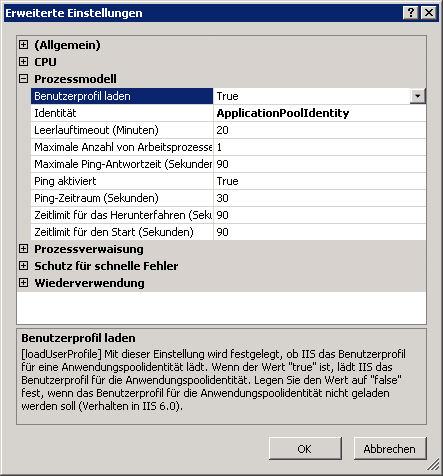Eine neue Website mit ASP.NET MVC 4, frisch auf einen Server publiziert, lieferte die Fehlermeldung:
Die Datei oder Assembly „DotNetOpenAuth.Core, Version=4.0.0.0, Culture=neutral, PublicKeyToken=2780ccd10d57b246“ oder eine Abhängigkeit davon wurde nicht gefunden. Die gefundene Manifestdefinition der Assembly stimmt nicht mit dem Assemblyverweis überein. (Ausnahme von HRESULT: 0x80131040)
Im Englischen klingt das ungefähr so:
Could not load file or assembly ‚DotNetOpenAuth.Core, Version=4.0.0.0, Culture=neutral, PublicKeyToken=2780ccd10d57b246‘ or one of its dependencies. The located assembly’s manifest definition does not match the assembly reference. (Exception from HRESULT: 0x80131040)
Nach viel Suchen, fand ich schließlich die Lösung:
Da ich dieses „DotNetOpenAuth.Core“ via NuGet installiert hatte, wurde in meiner lokalen Web.config-Datei automatisch Einträge ergänzt. Diese Einträge haben im öffentlichen Web auf dem Webserver noch gefehlt.
Hier der komplette Ausschnitt:
<runtime> <assemblyBinding xmlns="urn:schemas-microsoft-com:asm.v1"> <dependentAssembly> <assemblyIdentity name="System.Web.Helpers" publicKeyToken="31bf3856ad364e35" /> <bindingRedirect oldVersion="1.0.0.0-2.0.0.0" newVersion="2.0.0.0" /> </dependentAssembly> <dependentAssembly> <assemblyIdentity name="System.Web.Mvc" publicKeyToken="31bf3856ad364e35" /> <bindingRedirect oldVersion="0.0.0.0-4.0.0.0" newVersion="4.0.0.0" /> </dependentAssembly> <dependentAssembly> <assemblyIdentity name="System.Web.WebPages" publicKeyToken="31bf3856ad364e35" /> <bindingRedirect oldVersion="0.0.0.0-2.0.0.0" newVersion="2.0.0.0" /> </dependentAssembly> <dependentAssembly> <assemblyIdentity name="WebGrease" publicKeyToken="31bf3856ad364e35" culture="neutral" /> <bindingRedirect oldVersion="0.0.0.0-1.5.2.14234" newVersion="1.5.2.14234" /> </dependentAssembly> <dependentAssembly> <assemblyIdentity name="DotNetOpenAuth.AspNet" publicKeyToken="2780ccd10d57b246" culture="neutral" /> <bindingRedirect oldVersion="0.0.0.0-4.3.0.0" newVersion="4.3.0.0" /> </dependentAssembly> <dependentAssembly> <assemblyIdentity name="DotNetOpenAuth.Core" publicKeyToken="2780ccd10d57b246" culture="neutral" /> <bindingRedirect oldVersion="0.0.0.0-4.3.0.0" newVersion="4.3.0.0" /> </dependentAssembly> <dependentAssembly> <assemblyIdentity name="Microsoft.Data.OData" publicKeyToken="31bf3856ad364e35" culture="neutral" /> <bindingRedirect oldVersion="0.0.0.0-5.5.0.0" newVersion="5.5.0.0" /> </dependentAssembly> <dependentAssembly> <assemblyIdentity name="Microsoft.Data.Edm" publicKeyToken="31bf3856ad364e35" culture="neutral" /> <bindingRedirect oldVersion="0.0.0.0-5.5.0.0" newVersion="5.5.0.0" /> </dependentAssembly> <dependentAssembly> <assemblyIdentity name="System.Spatial" publicKeyToken="31bf3856ad364e35" culture="neutral" /> <bindingRedirect oldVersion="0.0.0.0-5.5.0.0" newVersion="5.5.0.0" /> </dependentAssembly> <dependentAssembly> <assemblyIdentity name="System.Net.Http" publicKeyToken="b03f5f7f11d50a3a" culture="neutral" /> <bindingRedirect oldVersion="0.0.0.0-2.2.13.0" newVersion="2.2.13.0" /> </dependentAssembly> </assemblyBinding>
Sobald ich das ergänzt hatte, war der Fehler weg.
